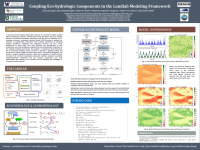CSDMS 2014 annual meeting poster Sai Siddhartha Nudurupati
Coupling Fluvial and Eco-hydrologic Components in the Landlab Modeling Framework
Erkan Istanbulluoglu, Unviersity of Washington Seattle Washington, United States. erkani@u.washington.edu
Greg Tucker, University of Colorado & CIRES Boulder Colorado, United States. gtucker@colorado.edu
Nicole Gasparini, Tulane University New Orleans Louisiana, United States. ngaspari@tulane.edu
Eric Hutton, CSDMS Boulder Colorado, United States. hutton.eric@gmail.com
Dan Hobley, University of Colorado Boulder Colorado, United States. Daniel.Hobley@colorado.edu
Jordan Adams, Tulane University New Orleans Louisiana, United States. <smmall>jadams15@tulane.edu
Abstract:
In arid and semi-arid regions, geomorphic response of a catchment is tightly coupled with Eco-hydrologic dynamics. Climate-driven biotic and abiotic processes strongly influence land-surface-atmosphere interactions and thus play an important role in landscape evolution. Landscape Evolution Models (LEMs) provide a platform for scientists to quantitatively understand these complex interactions by exploring testable hypotheses. Hydrology and vegetation dynamics are thus critical components of these LEMs. This work illustrates the development of such components and model-building by coupling fluvial and ecohydrologic components in the Landlab modeling environment. The Landlab is a component based framework for 2D numerical modeling, coded in Python. It provides a gridding module and allows users to either configure a model from scratch or use existing components. We present a coupled overland flow and vegetation dynamics model where vegetation is simulated based on inputs from stochastic precipitation generator, radiation component, potential evapotranspiration component and soil moisture component, and runoff is routed by overland flow component. This work demonstrates the flexibility of the Landlab and also highlights the advantages of component-based approach.
* Please acknowledge the original contributors when you are using this material. If there are any copyright issues, please let us know and we will respond as soon as possible.

